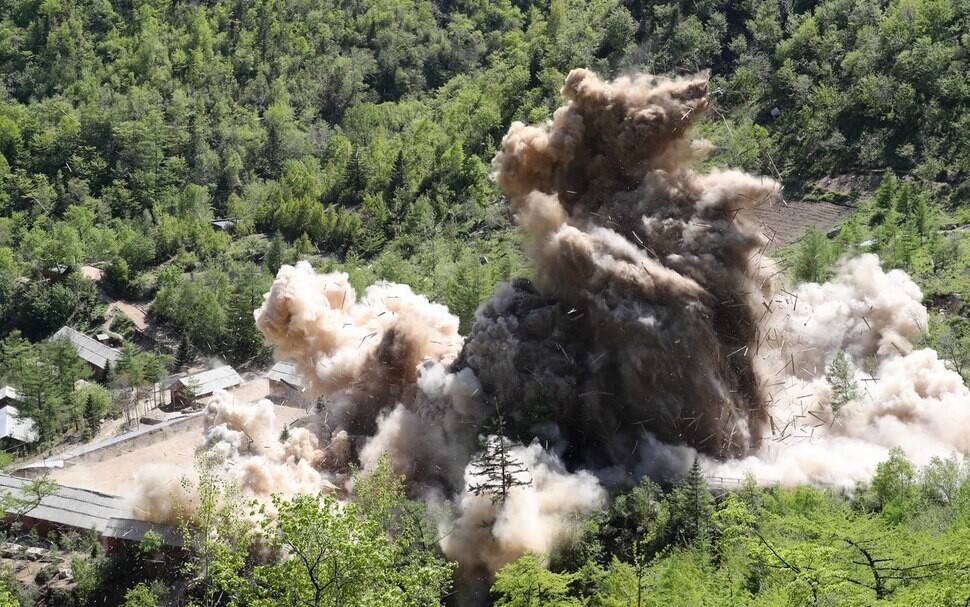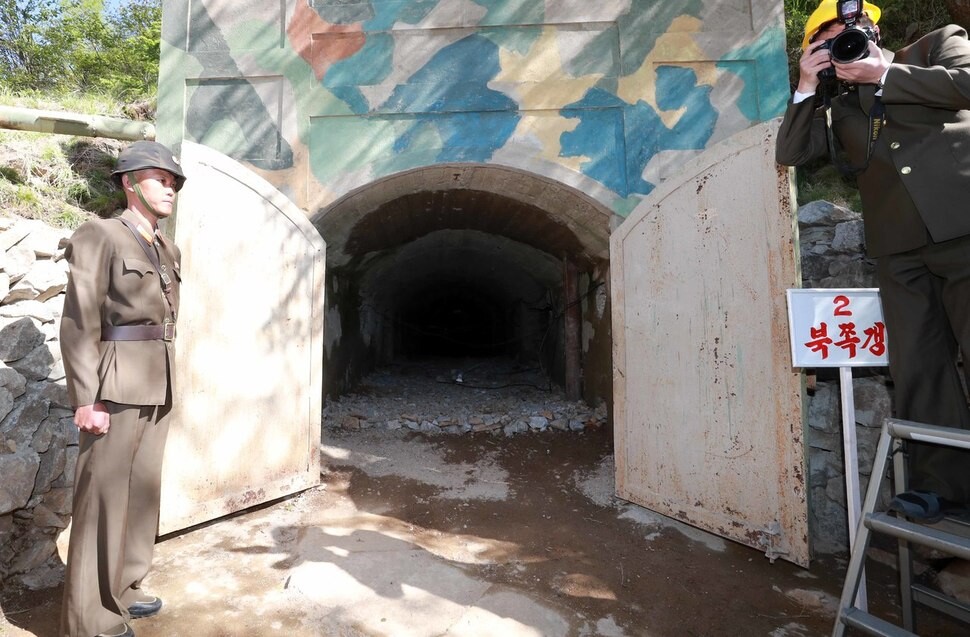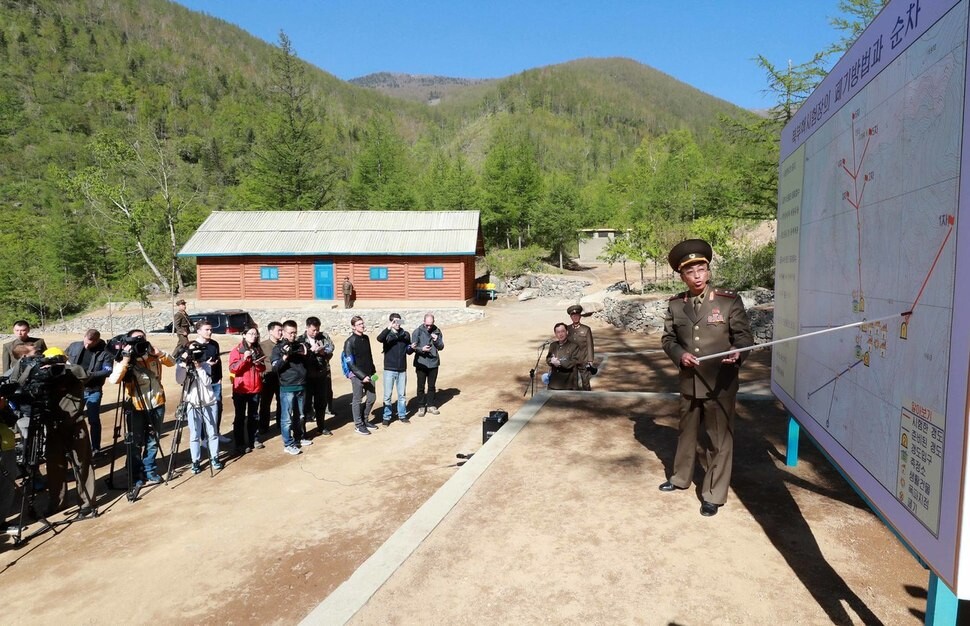hankyoreh
Links to other country sites 다른 나라 사이트 링크
North Korea seals off tunnels at nuclear test ground

North Korea set off a series of explosions on May 24 to seal off tunnels and related infrastructure at its “northern nuclear test ground” in a valley at Mount Mantap in Punggye Village, Kilju County, North Hamgyong Province. While leader Kim Jong-un was preemptively carrying out the first visible step toward the North’s “complete denuclearization,” US President Donald Trump moved the same day to abruptly cancel a scheduled summit with him in Singapore on June 12.
The cancellation marks the culmination of a battle of nerves that has been winding up between the two sides recently over the issues of joint South Korea-US military exercises and denuclearization approaches.
The event to mark the dismantlement of the Punggye Village test ground began with loud blasts to destroy Tunnel 2 to the north and an observation post at around 11 am that day. The site of five of the North’s six nuclear tests to date, Tunnel 2 is considered the symbolic heart of the Punggye nuclear test ground.

North Korea proceeded at 2:17 pm with the demolition of Tunnel 4 to the west and a metal forge. This was followed at 2:45 pm with the demolition of five buildings, including the headquarters for residential structures used by facility employees. Tunnel 3 to the south – which has never been used for nuclear tests and was seen alongside Tunnel 4 as being key to the day’s closure event – was blasted at around 4:02 pm.
The “ceremony” concluded with the demolition of local military barracks in increments of two blocks each at 15-minute intervals. Tunnel 1 to the east was not separately demolished that day, having already been closed down following the first nuclear test in Oct. 2006 due to radioactive contamination.
In a statement that evening, North Korea’s Nuclear Weapon Institute announced, “True to the decision of the Third Plenary Meeting of the Seventh Central Committee of the Workers' Party of Korea, the Nuclear Weapons Institute of the DPRK held a ceremony for completely dismantling the northern nuclear test ground of the DPRK on May 24, to ensure transparency of the discontinuance of nuclear test..”
“Dismantling the nuclear test ground was done in such a way as to make all the tunnels of the test ground collapse by explosion and completely close the tunnel entrances, and at the same time, explode some guard facilities and observation posts on the site,” it explained.
“there were neither leakage of radioactive materials nor any adverse impact on the surrounding ecological environment,” it added.

A quote from Nuclear Weapon Institute vice director Kang Kyong-ho published by Russia’s RIA Novosti news agency that day also drew notice.
“Now that it has been demolished, the Punggye Village nuclear test site cannot be restored. There are no other nuclear test sites or tunnels in North Korea besides the Punggye Village site,” Kang told reporters at the scene.
The event that day took place in the presence of a team of eight reporters from South Korea and 30 from the US, China, the UK, and Russia. The journalists departed Wonsan the previous day and arrived at the Punggye site early in the morning. Because of the remote mountain location, they remained out of contact with the outside until after 7 pm that day.
By Kim Ji-eun, staff reporter, and joint correspondent group

Editorial・opinion
![[Column] Season 2 of special prosecutor probe may be coming to Korea soon [Column] Season 2 of special prosecutor probe may be coming to Korea soon](https://flexible.img.hani.co.kr/flexible/normal/500/300/imgdb/original/2024/0426/3317141030699447.jpg) [Column] Season 2 of special prosecutor probe may be coming to Korea soon
[Column] Season 2 of special prosecutor probe may be coming to Korea soon![[Column] Park Geun-hye déjà vu in Yoon Suk-yeol [Column] Park Geun-hye déjà vu in Yoon Suk-yeol](https://flexible.img.hani.co.kr/flexible/normal/500/300/imgdb/original/2024/0424/651713945113788.jpg) [Column] Park Geun-hye déjà vu in Yoon Suk-yeol
[Column] Park Geun-hye déjà vu in Yoon Suk-yeol- [Editorial] New weight of N. Korea’s nuclear threats makes dialogue all the more urgent
- [Guest essay] The real reason Korea’s new right wants to dub Rhee a founding father
- [Column] ‘Choson’: Is it time we start referring to N. Korea in its own terms?
- [Editorial] Japan’s rewriting of history with Korea has gone too far
- [Column] The president’s questionable capacity for dialogue
- [Column] Are chaebol firms just pizza pies for families to divvy up as they please?
- [Column] Has Korea, too, crossed the Rubicon on China?
- [Correspondent’s column] In Japan’s alliance with US, echoes of its past alliances with UK
Most viewed articles
- 1[Column] Season 2 of special prosecutor probe may be coming to Korea soon
- 2‘We must say no’: Seoul defense chief on Korean, USFK involvement in hypothetical Taiwan crisis
- 3Division commander ordered troops to enter raging flood waters before Marine died, survivor says
- 4Is N. Korea threatening to test nukes in response to possible new US-led sanctions body?
- 5Is Japan about to snatch control of Line messenger from Korea’s Naver?
- 6No good, very bad game for Korea puts it out of Olympics for first time since 1988
- 7[Editorial] Korea’s surprise Q1 growth requires objective assessment, not blind fanfare
- 8Korea’s 1.3% growth in Q1 signals ‘textbook’ return to growth, says government
- 9N. Korean delegation’s trip to Iran shows how Pyongyang is leveraging ties with Moscow
- 10Amnesty notes ‘erosion’ of freedom of expression in Korea in annual human rights report